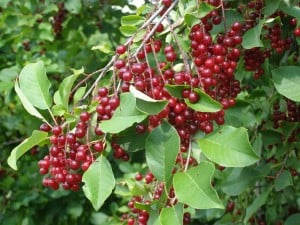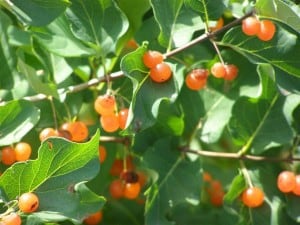On Wednesday afternoon (August 14) I walked the Trans-Canada Trail west from the foot path that goes up the steep hill to the bottom of Wallis Drive, past the blue bridge (near the pumping station entrance point on Parkhill Road at Ravenwood) to about 100 metres west of the orange bridge at Lily Lake. A number of wildflowers continue to bloom and most of the shrubs are heavily laden with fruit. In 40 minutes, however, I only saw two butterflies and, of course, no Monarchs.
FLOWERS IN BLOOM
White: Virgin’s Bower (vine that drapes itself over other plants, shrubs; esp. west of Lily Lake bridge), Flat-topped White Aster, Queen Anne’s Lace (a few), White Sweet Clover (a few), a few Red-osier Dogwoods were reblooming
Yellow: Black-eye Susan (abundant between the two bridges; probably planted from seed since it’s in the disturbed section; not attracting any insects; probably sterile), Canada Goldenrod (abundant), Grass-leaved Goldenrod, scattered Evening Primrose
Pink/mauve: Joe-pye Weed (east of blue bridge), Bouncing Bet, Purple Loosestrife (abundant in marsh between Lily Lake and Ackison Road), Bull Thistle (in with Black-eyed Susan; some has gone to seed and is being eaten by American Goldfinches), Large-leaved Aster (in shade; several), Fireweed (a few)
Purple: New England Aster (one only)
Orange: Touch-me-not (Spotted Jewelweed)
Green: Ragweed
FRUIT ON TREES AND SHRUBS
White: Red-osier Dogwood
Orange: Tartarian Honeysuckle (a few), American High-bush Cranberry, Climbing Bitter-sweet (yellow-orange)
Red: Tartarian Honeysuckle (abundant), American High-bush Cranberry, Staghorn Sumac, Choke Cherry,
Blue: Wild Grape, Silky Dogwood
Black: European Buckthorn
Green: Wild Cucumber pods, Common Milkweed pods
COLOUR CHANGE IN LEAVES
Red/burgandy: some of the Red-osier Dogwood and Virginia Creeper, many of the Red Maples at Lily Lake, some of the Nannyberry and American High-bush Cranberry
Orange: a few leaves on Sugar Maple, some of the Red Maples at Lily Lake
Yellow: Sensitive Fern, Spreading Dogbane
OTHER OBSERVATIONS
Birds: American Goldfinch, American Robin, Song Sparrow, European Starling, Northern Cardinal, Common Grackle, Eastern Kingbird, Cedar Waxwing, American Black Duck
Insects: ground-crickets calling non-stop, Fall Field Crickets calling occasionally, tree-crickets (toad-like, high-pitched non-stop call), Dog-Day Cicada calling, Carolina Locusts flying up from path flashing black and yellow on wings, one White Admiral butterfly, numerous White-faced Meadowhawks (a red or yellow, small dragonfly)
Amphibians: Northern Leopard Frog (several, in grassy verge)

